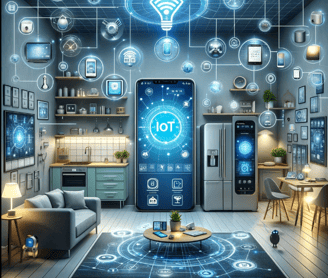Get to Know Internet of Things of IoT with 11Scripts
The Internet of Things (IoT) has emerged as a transformative force in modern households, fundamentally altering how we interact with our living spaces.
The Internet of Things (IoT) has emerged as a transformative force in modern households, fundamentally altering how we interact with our living spaces. This essay delves into the importance and nuances of IoT in contemporary homes, highlighting its role in enhancing convenience, promoting energy efficiency, and facilitating cost savings.
At its core, IoT represents a network of interconnected devices capable of collecting, exchanging, and acting on data without requiring human intervention. In the context of modern households, this translates to an ecosystem of smart devices that include everything from thermostats and lighting systems to appliances and security cameras. These devices offer unprecedented control and automation, marking a significant shift in how we manage and experience our home environments.
One of the most compelling benefits of IoT in households is its potential to significantly improve energy efficiency. Smart thermostats, for example, learn from our behaviors and preferences to optimize heating and cooling schedules, reducing energy consumption without sacrificing comfort. Similarly, smart lighting systems can adjust brightness based on the time of day or presence in a room, ensuring that energy is not wasted on illuminating unoccupied spaces. These innovations not only contribute to a more sustainable lifestyle but also translate to substantial savings on utility bills.
Moreover, IoT devices play a crucial role in enhancing the safety and security of modern homes. Smart security systems can monitor for intrusions, smoke, or water leaks in real-time, providing homeowners with immediate alerts and the ability to respond swiftly, even when they're away. This level of vigilance and connectivity can offer peace of mind, knowing that the home is protected by a network of intelligent devices working in concert.
Beyond energy savings and security, IoT simplifies and enriches daily life through convenience and personalization. Voice-activated assistants can control various aspects of the home environment, from playing music and managing schedules to controlling lights and appliances, all through simple voice commands. This hands-free control is particularly beneficial for individuals with mobility challenges, making the home more accessible and comfortable.
Incorporating Internet of Things (IoT) devices into your home can significantly enhance convenience, security, and energy efficiency. Here are 10 essential IoT devices that can transform a modern household:
Smart Thermostats: Devices like the Nest Learning Thermostat or Ecobee adapt to your schedule and preferences, automatically adjusting the temperature to save energy and provide comfort. They can be controlled remotely and provide insights into your energy usage.
Smart Lighting Systems: Philips Hue and LIFX are examples of smart lighting solutions that allow you to control the intensity, color, and schedule of your lights from your smartphone or through voice commands, helping to reduce energy consumption and enhance the ambiance.
Smart Locks: Devices such as August Smart Locks and Yale Assure Locks offer keyless entry, remote access, and the ability to grant temporary access to visitors, enhancing security and convenience.
Smart Security Cameras: Ring, Arlo, and Nest Cam provide real-time video surveillance of your home, accessible from your smartphone. These cameras often include features like motion detection, night vision, and two-way audio.
Smart Smoke and Carbon Monoxide Detectors: Devices like the Nest Protect can detect smoke and carbon monoxide, sending alerts to your phone and specifying the exact location of the danger in your home.
Smart Home Hubs: The Samsung SmartThings Hub and Amazon Echo serve as central points to connect and control all your smart home devices, enabling seamless integration and interaction between different gadgets.
Smart Plugs: Devices such as the TP-Link Kasa Smart Wi-Fi Plug allow you to turn traditional appliances into smart devices that can be controlled remotely, scheduled, and monitored for energy usage.
Smart Doorbells: Video doorbells like Ring Video Doorbell and Google Nest Hello let you see, hear, and speak to visitors at your door from anywhere, enhancing security and convenience.
Smart Appliances: Refrigerators, ovens, and washing machines from brands like Samsung and LG now come with smart capabilities, offering remote control, maintenance diagnostics, and customization options.
Voice Assistants: Amazon Echo (Alexa), Google Home (Google Assistant), and Apple HomePod (Siri) act as voice-controlled assistants that can manage other smart devices, play music, provide information, and assist with daily tasks.
Integrating these IoT devices into your home can create a more connected, efficient, and intelligent living environment, tailored to your lifestyle and needs.


